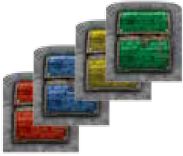
This section describes the Wiz-War components in detail.
Sectior Boards

These sector boards are used to build the game board.
Each sector board shows a map on each side: one with a classic layout from the original version of the game, and one with a new layout created for this edition.
Plastic Wizard Figures and Colored Bases

The plastic wizard figures represent the players' wizards during the game and are placed on the colored bases to indicate which player controls which wizard.
Each wizard figure has a unique appearance, but it does not affect gameplay.

Plastic Transformed Wizard Figures
The transformed wizard figures represent wizards who have changed into a different physical form.
Life Trackers

The life trackers correspond to the player colors and indicate a wizard's current life total.
A wizard's life total starts the game at "15", and a wizard dies if his life total is reduced to "0" or less (indicated by the skull on the dial).

Random Direction Overlay
The random direction overlay is used in conjunction with the die to determine random directions.

Treasure Markers
These markers correspond to the player colors and represent the treasures that the wizards are trying to steal from each other.
Object Markers

These markers indicate objects that may appear in the labyrinth (usually through the use of spells), as well as possible changes to the labyrinth itself.
Portal Markers and Plastic Stands

Portal markers indicate squares on the edges of the labyrinth that are connected to each other when it is not obvious that they are. Place each portal marker on a plastic stand.
Crack Tokens

Crack tokens are used to track damage on walls, doors, and other objects that can be damaged in the labyrinth.

Energy Tokens
These tokens indicate how much energy a spell has when cast, typically in order to track its duration or remaining uses.
Life Tracker Assembly

Assemble the life dials as shown in the diagram.
The Golden Rule
Many of the Magic cards in this game break the rules in a variety of ways. In case of a conflict, follow the text on that card.
Hat Tokens

Hat tokens correspond to the player colors and indicate which wizard is being affected by a particular spell.
They are also used to indicate which wizard is maintaining an object when there are multiple copies in the labyrinth.

Stun Tokens
Stun tokens indicate a wizard or creature who is stunned.

Magic Cards
Magic cards represent the different spells that a wizard can cast, items he can use, and energy he can utilize.
Four-sided Die

The die included with Wiz-War has four sides and is numbered 1-4. It is used to determine random directions, damage, and other random game elements. When a card or rule specifies to roll a die, use this die.
Sector Board Breakdown

1 Door
2 Outer Wall
3 Home Base Square
4 Treasure Start Square
5 Column
6 Stone Wall
Schools of Magic
A school of magic is a group of related spells. For instance, the Cosmetic school, although useless in the labyrinth (and therefore not included in this game), contains a variety of spells devoted to personal hygiene, hair, and skin care.
Each school has its own unique feel and specialization, as listed below.
Since all Magic cards have a common back, players must separate them before playing the game. Sort them into piles according to the icon in the lower-left corner of the card.
 Cantrip: The cantrip school is a special school containing spells known by all wizards who enter the labyrinth. Wiz-War contains two divisions of the cantrip school, but only one of them, White Cantrip, is used in the standard game.
Cantrip: The cantrip school is a special school containing spells known by all wizards who enter the labyrinth. Wiz-War contains two divisions of the cantrip school, but only one of them, White Cantrip, is used in the standard game.
The other, Black Cantrip, is only used when playing with the Custom Spellbook optional rule.

Alchemy: The school of Alchemy specializes in creating items. In particular, magic stones are a primary feature of alchemy. These mystic gems bestow a variety of useful powers upon anyone carrying them. Dedicated alchemists should be wary of fire, since it can shatter all of their carefully-crafted gemstones.

Conjuring: Conjurers are adept at creating inanimate objects, such as walls and thornbushes. When wizards duel using the school of Conjuring, the labyrinth is often left littered with an assortment of debris.

Elemental: This school of magic commands the powers of the four elements - wind, water, earth, and fire. Of all the schools, Elemental is the most deadly in combat because it contains mighty fireballs and lightning blasts.

Mentalism: Mentalism is the school of the mind. Using it, spells can be erased or even stolen from other wizards' minds. Energy to power spells is common in this school, but only in small bursts.

Mutation: A wizard who has mastered the school of Mutation can change his shape as easily as his clothes. Although the various transformations of this school are powerful, wise wizards remember that they all have weaknesses, and only one transformation can be used at a time.

Thaumaturgy: The final school of magic is the most ancient. It contains a well-balanced mix of traditional spells, as well as an above-average amount of magical energy. Wizards seeking versatility should look no further than the school of Thaumaturgy.
Continue Reading


